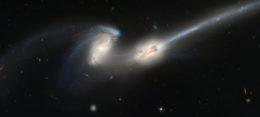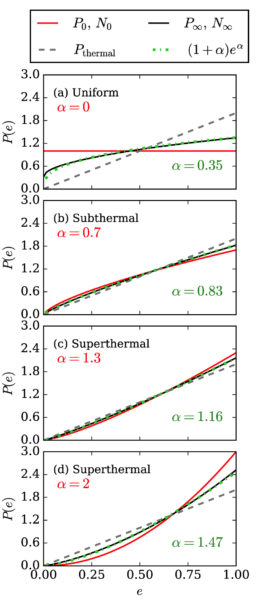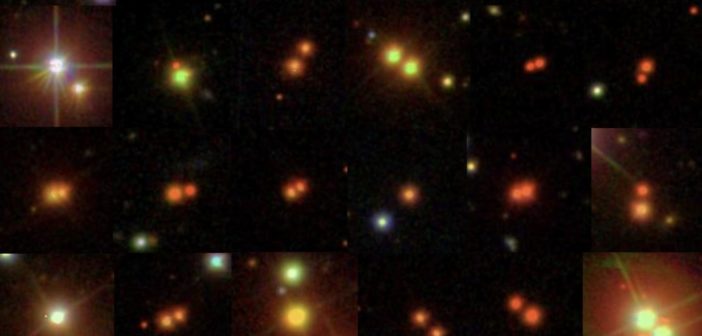Many stars travel through space with a binary companion, and large-scale surveys allow us to study enormous numbers of these stellar pairs. What do these surveys tell us about the characteristics of binary stars in the Milky Way?

Tidal forces are perhaps best known for generating tidal tails and streams in interacting galaxies, but a galaxy’s tidal pull can have subtle effects on binary star systems as well. [NASA, H. Ford (JHU), G. Illingworth (UCSC/LO), M. Clampin (STScI), G. Hartig (STScI), the ACS Science Team and ESA]
Stars Awash in the Galactic Tide
The orbital parameters of a binary star system — namely, the distance between the stars and how eccentric (non-circular) their orbits are — can encode information about the formation and evolution of the binary system as well as the evolution of the stars themselves. The orbits of binary stars are susceptible to outside influence, too; gravitational nudges from passing stars, nearby gas clouds, and the overall tidal pull of the galaxy can change a binary system’s orbits over time.
When we examine the orbits of binary systems in the Milky Way with observations from the sky-mapping Gaia spacecraft, we find unexpected trends in the orbital parameters of binary systems near the Sun. Namely, among binary systems separated by large distances (>1,000 au), there are more systems with highly eccentric orbits than expected. What’s the origin of this trend?
Nature vs. Nurture

The final distribution of eccentricities (black lines) and best-fitting power laws (green lines) acquired from various initial distributions (red lines). These results show that a superthermal eccentricity distribution, as is seen in binary systems near the Sun, can only arise from a distribution that is initially superthermal. [Adapted from Hamilton 2022]
Hamilton approached this problem by modeling the effects of the Milky Way’s overall gravitational pull on populations of synthetic binary stars in the outer regions of the galaxy. In order to test the effects of nature as well as nurture, Hamilton modeled populations with different initial eccentricity distributions: uniform (all eccentricities are equally common), thermal (the binaries have reached statistical equilibrium through gravitational interactions; represented by the gray lines in the figure to the right), subthermal (fewer eccentric binaries than the thermal case), and superthermal (more eccentric binaries than the thermal case, as we see near the Sun).
Maybe They’re Born with It, Maybe It’s the Tidal Influence of the Milky Way
The model results show that the tidal pull of the Milky Way tends not to change the eccentricity distribution of a population of binary stars. Put another way, this means that the high number of wide, eccentric binary systems in the solar neighborhood can’t have been caused by the Milky Way’s gravitational influence — another factor, such as the combined effects of individual gravitational nudges from passing stars and gas clouds, must have caused this trend, or binary systems in the solar neighborhood must be born with a similar distribution of eccentricities.
As is so often the case, there’s plenty more work to be done to understand this issue fully. In particular, modeling the effects of gravitational tugs from passing stars and applying new techniques to study the time evolution of binary systems will be critical to reaching a conclusion.
Citation
“On the Phase-mixed Eccentricity and Inclination Distributions of Wide Binaries in the Galaxy,” Chris Hamilton 2022 ApJL 929 L29. doi:10.3847/2041-8213/ac6600
